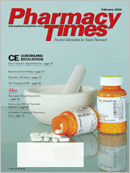Publication
Article
Pharmacy Times
Nausea and Vomiting—A Wretched Experience
Author(s):
Bill Russell was a hall of fame basketballplayer for the BostonCeltics in the 1960s. He wasfamous for his defensive ability, rebounding,and leadership and, strangely, for hisritual of vomiting prior to every game.Most of us, with the possible exceptionof bulimics, would fear vomiting morethan playing against Wilt Chamberlain(another superstar of that same era).
Anyone who has experienced an upsetstomach, queasiness, pallor, copiousamounts of saliva, and chills, all followedby the sudden forceful, frightening expulsionof stomach contents, would surelyagree that vomiting is not fun. The aftertastesickens us even more, the color andtexture of the fluid are repellent, and theodor is foul and unforgettable. Vomitingthus begets more vomiting.
The nausea and vomiting cascade canbe the result of food poisoning and manyother causes. Nausea is the most frequentcomplaint for which patients consultphysicians.1 Cancer patients undergoingchemotherapy rank it as the worstpart of treatment, and women who havehad children recall their experience withnausea long after the pain of childbirthfades from memory.
As pharmacists, we soon learn thatnausea is one of the major side effects ofmany drugs. Unfortunately, we are lessknowledgeable about its physiology, etiology,and management. This article willbriefly address each of these topics andlist a number of drugs frequently associatedwith nausea and vomiting.
Physiology
The word nausea is borrowed almostdirectly from the Greek word nausia,which means "seasickness."Only laterdid nausea acquire the broader meaning.Vomit comes from the Latin vomere, "tothrow up from the stomach."2 Emesiscomes from the Greek emetikos, "tovomit."Sometimes emesis is used toencompass both nausea and vomiting.Nausea can be defined as an unpleasantbut not painful sensation associated withthe back of the throat and the gut andgiving rise to the feeling that vomiting isimminent.
Nausea disturbs normal stomachrhythm, causing a slowing or completecessation of gastric motility, which stopsdigestion of food and absorption of toxins.When nausea occurs, secretion ofgastric acid decreases and salivationincreases. Tachycardia also can occur.
Nausea does not necessarily culminatein vomiting. The latter is defined asa forceful expulsion of gastric contentsproduced by involuntary contraction ofthe abdominal musculature when thegastric fundus and the lower esophagealsphincter are relaxed.3 Vomiting is for themost part a protective mechanism—itpreserves survival.4 This aspect is evidentin those instances where poisonous substancesare ingested. Vomiting expelsthe material from the body and removesthe danger.
The process, however, is not as easy toexplain in cases of motion sickness ormorning sickness. Neither condition(being in motion or being pregnant) isparticularly harmful or undesirable.3Motion sickness develops due to a sensorymismatch involving the visual,vestibular (the inner ear), and proprioceptive(sensory) systems.5 Morning sicknessmay have evolved to reduce anembryo's exposure to natural toxins.1Hormonal changes that include higherlevels of circulating estrogen, humanchorionic gonadotropin, and thyroxinealso may play a role. These agents maydirectly stimulate the chemoreceptorcells in the medulla, adjacent to the pointwhere the emetic response is believed tobe coordinated.5
The vomiting reflex is triggered bystimulation of chemoreceptors in theupper gastrointestinal (GI) tract andmechanoreceptors in the wall of the GItract, which are activated by both contractionand distention of the gut as wellas by physical damage. A coordinatingcenter in the central nervous systemcontrols the emetic response. Afferentnerves to the vomiting center arise fromthe abdominal splanchnic and vagalnerves, the vestibulolabyrinthine receptors,the cerebral cortex, and thechemoreceptor trigger zone (CTZ).6 TheCTZ is located in the brain outside theblood-brain barrier, and therefore it issensitive to agents circulating in theblood. Ingested toxins may stimulatechemoreceptors or may release 5-hydroxytryptamine (5-HT) from enterochromaffincells in the gut wall. Thisaction can result in vagal stimulation, andpathways to the CTZ are stimulated.
Etiology
Vomiting can be caused by a diverserange of factors, all of which trigger thesame mechanism. A psychological componentalso is involved. Factors such asfoul smells, horrific sights, and violentmotion (in travel) are external events perceivedby higher brain centers and translatedinto the act of vomiting. Other factorshave more obvious physical or chemicalactions, such as overindulgence in food ordrink, chemotherapy, chemicals includingpesticides, bites and stings, some plants,opiate analgesics, or radiation.4
A number of diseases or conditionsare associated with nausea and vomiting.They include adrenal insufficiency,hepatitis, Reye's syndrome, Addison'sdisease, diabetic ketoacidosis, myocardialinfarction, hypercalcemia, some cancers,bacterial or viral infections, multiplesclerosis, labyrinthitis, vestibular neuronitis,pancreatitis, diabetic gastroparesis,irritable bowel syndrome, gallstones,peptic ulcers, gastroesophageal reflux,and intestinal obstruction.
Other causes include extreme pain,surgical procedures, raised intracranialpressure, and anxiety.4 Anxiety-inducing,threatening, or distasteful circumstancescan result in so-called self-induced psychogenicvomiting. Vomiting may expresshostility, as when a child vomitsduring a temper tantrum.3
Drugs as Causes
As mentioned earlier, many drugs—including anesthetic agents, together withchemicals and biologicals—can causenausea and vomiting as manifestations ofsystemic toxicity.5 Chemotherapeuticdrugs are notorious for their emetogenicproperties. The severity of chemotherapyinducedemesis depends on the particulardrug used, the dose of the drug, and themethod of administration.6 Unfortunately,the fact that most cancer treatmentscause vomiting is common knowledge.This expectation creates anxiety, whichcompounds the problem for the pharmacist,nurse, and physician.
Women who undergo chemotherapyare more prone to vomiting than men, andyounger patients are more susceptible.Young patients also are more prone to theside effects of certain antiemetics.4 Otherfactors predisposing patients to nauseaand vomiting with chemotherapy includealcohol intake, previous morning sicknessor motion sickness, course of treatment,poor antiemetic control in the past, andthe treatment setting.
It has been found that chemotherapypatients actually experience 3 separatetypes of nausea and vomiting. An"acute"type occurs within minutes tohours of receiving a dose and then graduallyresolves. In many patients, the nauseaand vomiting return after a day or 2,an effect called "delayed emesis."About25% of patients have "anticipatory nauseaand vomiting,"with symptomsoccurring before the drugs are administered.There is no current antiemeticdrug treatment for this last type.1
Many commonly used drugs areknown to cause nausea and vomiting.They include acetaminophen (earlysymptoms of overdose), antibiotics, AIDSdrugs, selective serotonin reuptakeinhibitors, antiparkinsonian drugs, calciumchannel blockers, digoxin, digitoxin,phenytoin, disulfiram, ipecac, quinidine,thyroid drugs, theophylline, and caffeine.Package inserts generally will list the incidenceof nausea and vomiting reportedin a drug's clinical trial in the AdverseReactions section.
Treatment
The choice of an appropriate antiemeticdrug will depend on a variety of factors:the cause of the nausea and vomiting,patient demographic factors, the dosageform and method of administration, andthe risk of extrapyramidal reactions orother side effects.4 Antiemetics are composedof a pharmacologically diversegroup of drugs. Many were not developedfor this use but were borrowed fromother areas of medicine serendipitously.This situation changed with the understandingof the role of 5-HT in emesis andthe development of selective 5-HT3-receptor antagonists (5-HT3 is the 5-HTreceptor involved in vomiting).
The majority of currently availableantiemetics are dopamine receptorantagonists.4 Dopamine is involved in thecontrol of gastric motility, and dopaminereceptor antagonists are used in a varietyof GI disorders. Drug classes used fornausea and vomiting include phenothiazines,which act in the CTZ to blockdopamine receptors; antihistamines,which act at the level of the vestibularafferents; prokinetic or cholinergicagents; anticholinergics; 5-HT3 receptorantagonists, which include ondansetronand granisetron; corticosteroids; tetrahydrocannabinol(the active ingredient inmarijuana); benzodiazepines; tricyclicantidepressants; bismuth subsalicylate;ginger; and the newest, neurokinin-1 orsubstance P antagonists.6
Final Thoughts
It has been quite common to think ofnausea and vomiting as part of the samephenomenon. A drug that affects one,however, may not affect the other,because separate programs in the brainmay be involved. Additionally, there are ahost of pathways to the brain responsiblefor vomiting, and nausea can be triggeredby a host of different stimuli. Thus,all of the currently used drugs have theirlimitations, and uncontrolled nausearemains a persistent problem.1
Mr. Sherman is president of ShermanConsulting Services Inc.
For a list of references, send astamped, self-addressed envelope to:References Department, Attn. A. Stahl,Pharmacy Times, 241 Forsgate Drive,Jamesburg, NJ 08831; or send an e-mailrequest to: [email protected].Antiemetics are composed of apharmacologically diverse group ofdrugs.







